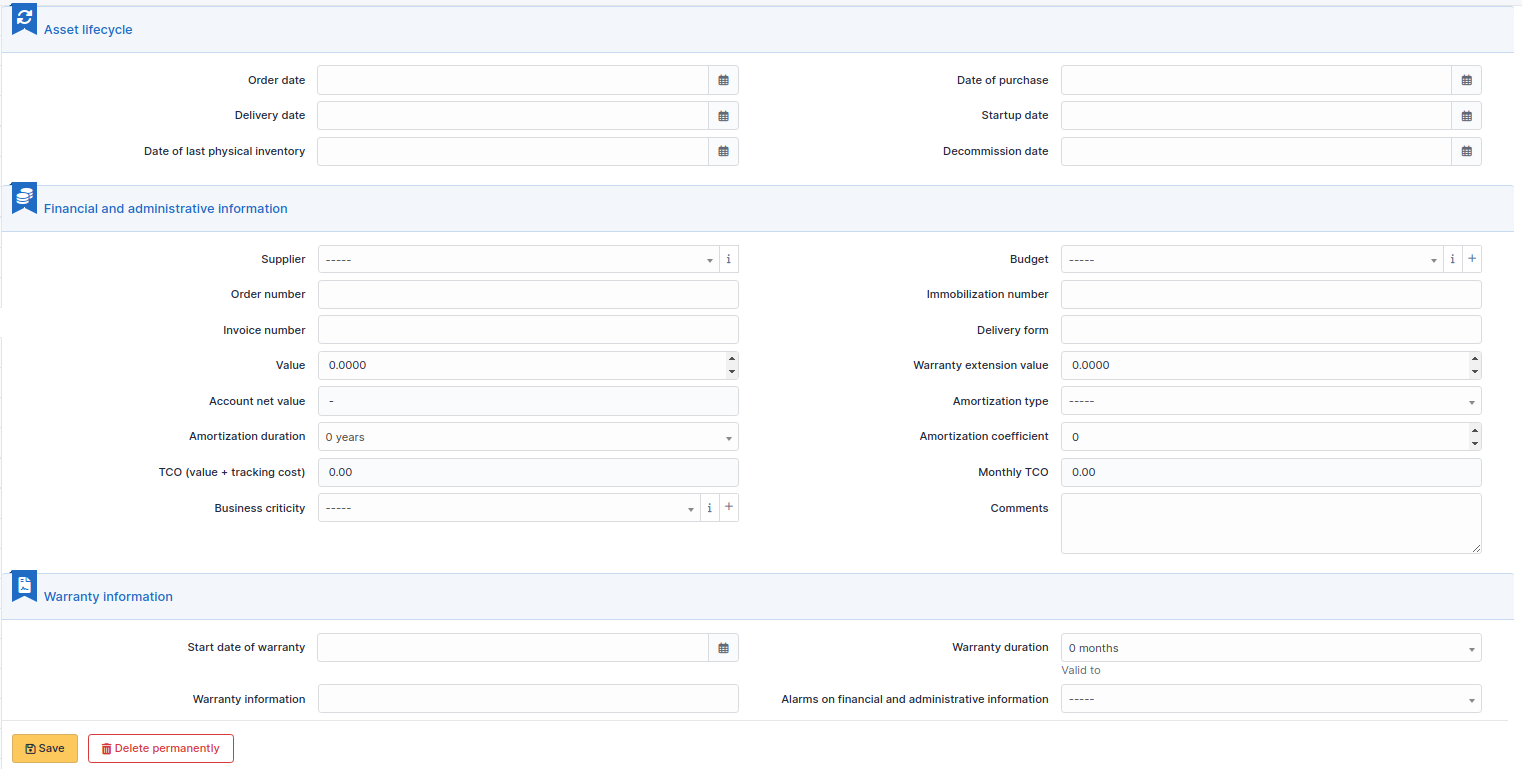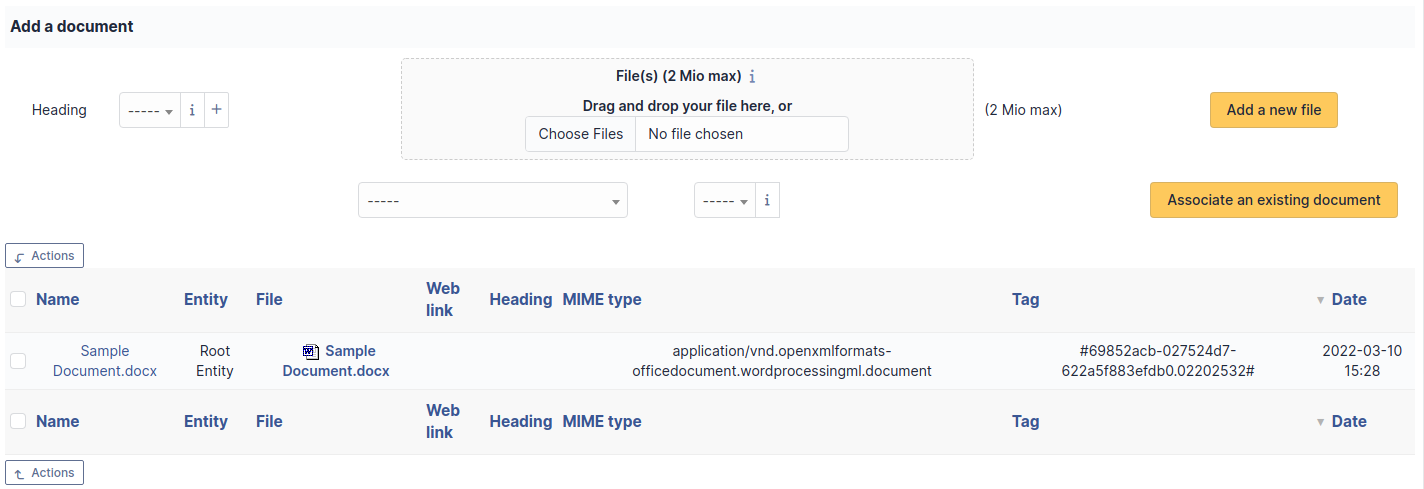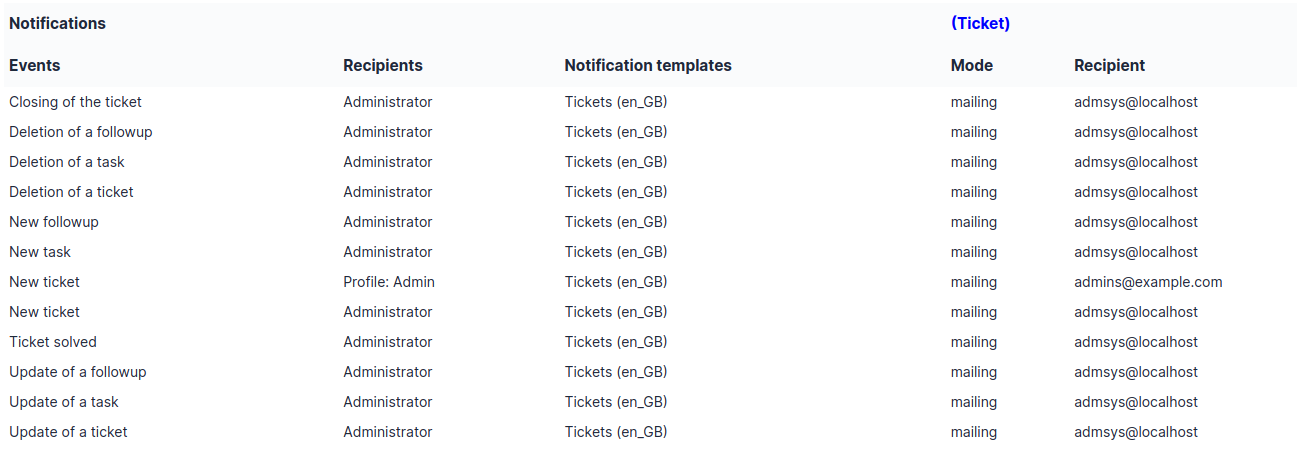Software¶
GLPI allows management of software and their versions as well as licenses, associated or not to software versions.
A software is by default associated with an entity.
Financial management is done at the level of licenses; the financial management at software level is only a model for the licenses associated with this software.
Software can be imported automatically using a third-party inventory tool; in this case a dictionary can be used to filter or clean the import data (see [Configure data dictionaries](07_Module_Administration/06_Dictionnaires.rst « The dictionaries are managed from menu entry Administration > Dictionaries »)).
Some fields are specific in the software form:
Update is an information, with no processing associated and which tells whether the software is an update of another software
Category allows to group software in the list of software of an asset
Can be associated with a ticket defines whether the software can be seen in the drop-down list « Hardware » of a ticket
It is recommended to first create the software without a version number in the name, then to create the versions and last to create the licenses.
Note
In multi-entity mode, the list of software can rapidly become long because of double entries (one software per entity). A better approach can consist in grouping identical software in the same entity (see tab Grouping below), then to make recursive the elements that can be made recursive.
It is possible to use templates with software.
The different tabs¶
Versions¶
A version of a software is the element that can be installed on a asset; see also *Installations* tab.
The main view lists the number of installations of the version.
Specific fields:
Name: the version number
Status: in ITIL recommendations, it allows to follow the DSL (library storing authorized versions)
Operating system: the operating system on which this software version runs
Installations: the number of installations of the version
Comment: some comments
Licenses¶
Installations¶
The installation of a software on a computer is visualized through a version and can be consulted on a software form (list of computers having at least one version installed), on a version form (computers having this version installed) and finally on a computer form (list of versions of installed software, sorted by category).
Note
Column license is filled only when the license is affected to the concerned computer
The initial display of different categories depend upon user preferences (see [manage preferences](01-premiers-pas/03_Utiliser_GLPI/04_Gérer_ses_préférences.rst »).
Two options are available on the list of installations of software on a computer. Above the list, Install allows to install manually a version of a software on the computer, by selecting first the software and its version; if a license is associated with this software, the use version of the license is automatically selected.
To Uninstall a version of a software, mass actions must be used: first select the versions to be uninstalled, then select Suppress definitively. If a license is affected to the computer, it remains affected but its use version is erased.
Following the list of installed versions, the list of affected but non installed licenses is displayed. It is possible to add a new license to the computer. Mass actions allow, via the action Install, to install a use version of selected licenses.
Management¶
Management of financial and administrative information, this information is visible in the “Management” tab on the computer’s form.

By default this management is disabled. It is possible to activate the financial information on any type of object in the inventory by using the link in the Management tab of the material detail.

Note
It is possible to activate the administrative and financial information from the massive actions on a set of elements (computer, monitor, …)
Note
It is possible to activate the administrative and financial information as soon as an element is created. See « Enable default administrative and financial information » option in Setup > General > Asset tab.
Financial information consists of the following items:
Lifecycle¶
Order date
Date of purchase
Delivery date
Date of implementation
Date of last physical inventory
Date of reform
Financial and administrative information¶
Supplier: Third party who sold the equipment. See Managing suppliers. Suppliers are managed from the menu Management > Suppliers.
Order number : number of the order of the equipment.
Asset number.
Invoice number: equipment invoice number.
Delivery note: delivery note for the equipment.
Value: cost of the equipment.
Warranty extension value: cost of the warranty extension, but preferably use contracts.
Account net value: this is the automatic calculation of the gross value of a piece of equipment minus the amount of depreciation.
Type of depreciation: choice of the type of depreciation between linear and declining balance.
Depreciation period: depreciation period expressed in years.
Depreciation coefficient: coefficient applied to a straight-line depreciation type in order to obtain the values of the declining balance type. It is therefore only used if the type of depreciation is declining balance.
TCO (value+amount of interventions): the total cost of ownership which includes all the constituent elements of an invoiced product.
Budget: the budget on which this equipment was purchased See Managing the budget.
Order date: date on which the material was ordered.
Purchase date: date on which the equipment was purchased.
Delivery date: date on which the equipment was delivered.
Startup date: date on which the equipment was put into service.
Date of last physical inventory: date of the last physical inventory of the equipment.
Comments.
Monthly TCO: TCO divided by the number of months between today’s date and the date of purchase of the equipment.
Warranty information¶
Warranty start date: date on which the warranty of the equipment starts
Warranty information: text qualifying the warranty
- Warranty period: duration of the warranty expressed in months
If a warranty start date and a warranty period are set, the information « Expires on » will appear with a date in red if it is earlier than the current date
All the dates defined can be managed automatically according to changes in the status of the equipment. Some dates can also be copied from another date. All this configuration is done by [entity](administration_entity_delegation.dita).
Tips¶
GLPI allows you to configure a notification on the expiry of the hardware warranty. This is configurable by entity in notification management to define the models and recipients used and in the administration of entities to enable or disable this feature, define the default values and anticipate the sending of the notification if necessary.
GLPI can perform a simple net book value calculation based on straight-line or declining balance depreciation. To do so, a certain amount of information (value, date, etc.) must be entered. The user must also enter the date of the financial year the general configuration.
The display of financial information for each type of equipment depends on the profile of the user logged in.
Associated Contracts¶
The Contracts tab is used to show or add linked contracts.

For each associated contract, the name, number, contract type, supplier, start date and initial duration of the contract are listed. In the last field, the end date of the contract is also shown with a red display if the date is earlier than the current date.
Refer to contract management for more information.
Documents¶
Additional information is stored in the form of external documents which are files uploaded into GLPI. In the Documents tab, documents can be associated and unlinked with the selected item. The management of the documents themselves is dealt with in another chapter.
It is also possible to quickly create a document via this tab by specifying the desired file and optionally the field in which the new document is to be placed. The name of the created document will be based on the name of the added file.

Note
When you delete a document from this tab via mass actions, you only remove the link between the object and the document; the document itself is still present.
Tickets¶
The Tickets tab is used to create a ticket associated with the current object. It also lists the tickets already linked to the object.

Note
A second table lists the tickets attached to the linked elements
Note
Any deletion or addition of a ticket is recorded in the history.
Problems¶
The Problems tab is used to create a problem associated with the current object. It also lists the changes already linked to the object.
This summary table includes for each object:
Status
Date (opening or expiry date, resolution or closing date depending on the status of the problem)
Priority
Requestor(s) and assigned technician(s)
Associated elements
Category
Name
Column indicating the number of scheduled tasks

Note
A second table lists the problems attached to the related elements
Note
Any deletion or addition of a problem is recorded in the history.
Associated External Links¶
The External links tab is used to show associated external links.
For some items, external links are managed from the menu Setup > External links.
These links can use object fields such as IP, name, etc. See Configure protocol external links.
Examples:
A web link: http://192.168.0.1 (IP retrieved from the network port of the hardware) ;
A RDP link for remote access: glpi://MSTSC.EXE,pc001 (name « pc001 » retrieved from the hardware).
Notes¶
The Notes tab provides a free text field for storing additional information. Notes are displayed in the order of their creation.

À faire
Fix this reference (include or link???) [Onglet « Réservations »](Les_différents_onglets/Onglet_Réservations.rst) Gestion des réservations pour un objet d’inventaire
History¶
The History tab is used to show any changes made to an item. The following information about the changes is available:
ID of the change.
Date and time the change was made.
User who made the change. If this field is not filled, it means that the action was done automatically (For example: automatic inventory update).
Field that was changed.
Description of the change that was made.
The description of the change represents either the difference between the old and the new value (For example with location field: Change HQ to Remote Office A), or the explanation of the action which was carried out (For example: Uninstallation of a software: « Gimp 2.0 »).
Note
For dropdowns or objects with a parent/child relationship, the modification of a child will appear in the history of the parent element.
Grouping¶
This section describes how to group software having same names in sub-entities, allowing to group software of child entities into mother entity.
Note
This is only available for multi-entities platforms.
How to realize a grouping:
If the software does not exist in mother entity, create in this mother entity a software whose name is strictly identical to the name of software in child entities
Open the form of the software of the mother entity
Activate recursivity (sub-entities to Yes at top right); this will make a new tab Grouping appear after tab History
Open this tab; a list displays software having same names in child entities
Select appropriate lines and validate grouping
Avertissement
This operation cannot be undone
This grouping have the following effects:
Licenses are attached to the software in mother entity, but stay in origin sub-entities
Versions are merged, no more doubles in mother entity
Old software are moved to the trash
Note
When using a third-party inventory tool, some extra steps are mandatory:
Empty trash after grouping, otherwise synchronization will restore the old software in case of new version
Associate the same vendor to the new software; as the synchronization checks vendor name, a new software would then be created
Debugging information¶
If you have Debug mode enabled in your preferences, a Debug tab will appear before the All tab. This tab offers information to help you resolve an issue.
For example, for a computer, you have one or more tables depending on the affected object (financial information, reservations…) listing the notifications that will be triggered on this computer with:
Triggering event
Recipient(s)
Notification model used
Recipient(s) email address

All Information¶
For an item, all information is displayed on one page from the All tab. This shows all of the tabs of an object’s form in one view, one below the other.
The different actions¶
Apart from common actions, some actions are specific to software:
[Manage licenses](03_Module_Parc/04_Logiciels/Onglet_Licences.rst) From menu *Assets > Softwares* click on license name in tab Licenses.